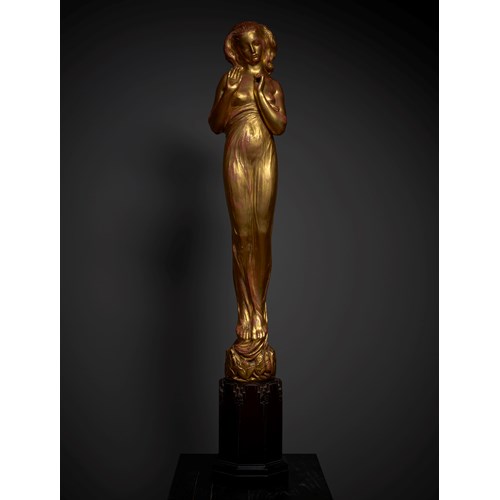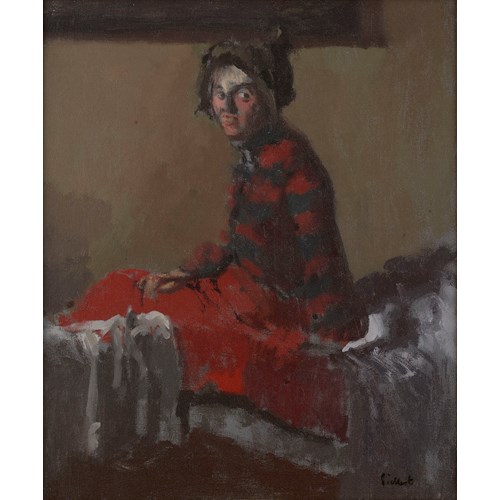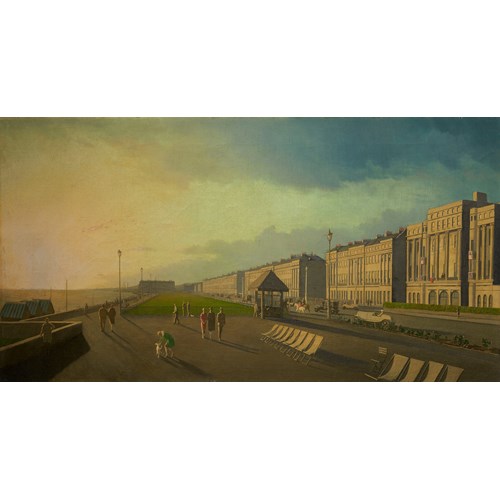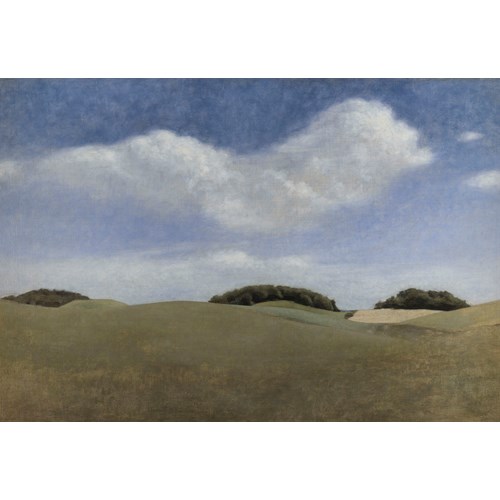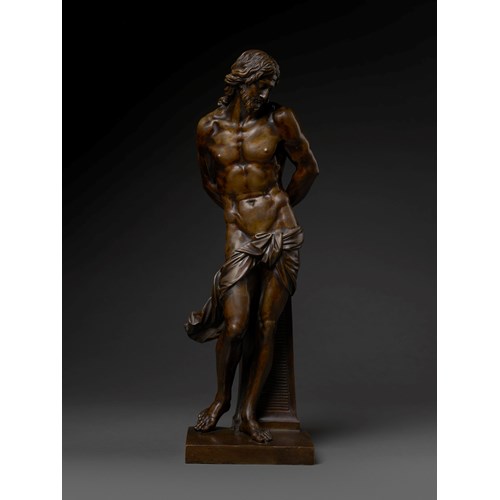Marketplace
Barnstaple Bay, North Devon
David BOMBERG
Barnstaple Bay, North Devon
Date 1947
Medium Oil on canvas
Dimension 52 x 66 cm (20¹/₂ x 26⁰/₁ inches)
Bomberg was one of the most audacious of the exceptional generation of artists who studied at the Slade School of Art under Henry Tonks, and which included Mark Gertler, Stanley Spencer, C.R.W. Nevinson, and Dora Carrington. Bomberg painted a series of complex geometric compositions combining the influences of cubism and futurism in the years immediately preceding World War I; typically using a limited number of striking colours, turning humans into simple, angular shapes, and sometimes overlaying the whole painting a strong grid-work colouring scheme. He was expelled from the Slade School of Art in 1913, with agreement between the senior teachers Tonks, Frederick Brown and Philip Wilson Steer, because of the audacity of his breach from the conventional approach of that time.
Whether because his faith in the machine age had been shattered by his experiences as a private soldier in the trenches or because of the pervasive retrogressive attitude towards modernism in Britain Bomberg moved to a more figurative style in the 1920s and his work became increasingly dominated by portraits and landscapes drawn from nature. Gradually developing a more expressionist technique, he travelled widely through the Middle East and Europe.
From 1945 to 1953, he worked as a teacher at Borough Polytechnic (now London South Bank University) in London, where his pupils included Frank Auerbach, Leon Kossoff, Philip Holmes, Cliff Holden, Edna Mann, Dorothy Mead, Gustav Metzger, Dennis Creffield, Cecil Bailey, and Miles Richmond. David Bomberg House, one of the student halls of residences at London South Bank University, is named in his honour. He was married to landscape painter Lilian Holt.
A great period of painting and drawing in landscape followed, in Spain at Toledo (1928), Ronda (1934–35 and 1954–57) and Asturias (1935), in Cyprus (1948) and intermittently in Britain, perhaps most powerfully in Cornwall and Devon, where the present beautiful, almost Turneresque seascape was painted.
A six-month stay at Odessa in the Soviet Union in the second half of 1933, following Hitler's seizure of power in Germany, led Bomberg on his return to London to immediate resignation from the Communist Party. During World War II, he painted Evening in the City of London (1944), showing the blitzed city viewed rising up to a triumphant, surviving St Paul's Cathedral on the horizon, since described as the "most moving of all paintings of wartime Britain" (Martin Harrison); a series of flower paintings saturated with turbulent feeling; and his single commission as a war artist, a series of "Bomb Store" paintings (1942) expressing Bomberg's expanded first-hand sense of the destructive powers of modern technology in warfare. These "Bomb Store" paintings convey a premonitory sense of the massive explosion that destroyed the underground store two years later, killing around 70 people, and bear comparison with Piranesi's Carceri etchings.
Bomberg's superb draughtsmanship was expressed also in a lifelong series of portraits, from the early period of his Botticelli-like "Head of a Poet" (1913), a pencil portrait of his friend the poet Isaac Rosenberg for which he won the Henry Tonks Prize at the Slade, to his "Last Self-Portrait" (1956), painted at Ronda, a meditation also on Rembrandt.
Unable to get a teaching position after World War II in any of the most prestigious London art schools, Bomberg became the most exemplary teacher of the immediate post-war period in Britain, working part-time in a bakery school at the Borough Polytechnic (now London South Bank University) in the working-class borough of Southwark. Though his students received no grant and were awarded no diploma, he attracted devoted and highly energetic pupils, with whom he exhibited on an equal basis in London, Oxford, and Cambridge in two important artists' groupings in which he was the leading light, the Borough Group (1946–51) and the Borough Bottega (1953–55). He developed a deeply considered philosophy of art, set out in several pieces of writing, which he summed up in the phrase, "The Spirit in the Mass".
Following a collapse in Ronda, Bomberg died in London in 1957, his critical stock rising sharply thereafter. One of Bomberg's admirers, the painter Patrick Swift, unearthed and edited Bomberg's pensées, and was later to publish them, along with images of Bomberg's work, as 'The Bomberg Papers' in his ‘X’ magazine (June 1960).
After his early success before the First World War, he was in his lifetime the most brutally excluded artist in Britain. Having lived for years on the earnings of his second wife, fellow artist Lilian Holt and remittances from his sister Kitty, he died in absolute poverty.
Bomberg is today considered one of Britain’s greatest twentieth century painters, as his work as been critically reconsidered in a number of important monographic museum exhibitions.
Whether because his faith in the machine age had been shattered by his experiences as a private soldier in the trenches or because of the pervasive retrogressive attitude towards modernism in Britain Bomberg moved to a more figurative style in the 1920s and his work became increasingly dominated by portraits and landscapes drawn from nature. Gradually developing a more expressionist technique, he travelled widely through the Middle East and Europe.
From 1945 to 1953, he worked as a teacher at Borough Polytechnic (now London South Bank University) in London, where his pupils included Frank Auerbach, Leon Kossoff, Philip Holmes, Cliff Holden, Edna Mann, Dorothy Mead, Gustav Metzger, Dennis Creffield, Cecil Bailey, and Miles Richmond. David Bomberg House, one of the student halls of residences at London South Bank University, is named in his honour. He was married to landscape painter Lilian Holt.
A great period of painting and drawing in landscape followed, in Spain at Toledo (1928), Ronda (1934–35 and 1954–57) and Asturias (1935), in Cyprus (1948) and intermittently in Britain, perhaps most powerfully in Cornwall and Devon, where the present beautiful, almost Turneresque seascape was painted.
A six-month stay at Odessa in the Soviet Union in the second half of 1933, following Hitler's seizure of power in Germany, led Bomberg on his return to London to immediate resignation from the Communist Party. During World War II, he painted Evening in the City of London (1944), showing the blitzed city viewed rising up to a triumphant, surviving St Paul's Cathedral on the horizon, since described as the "most moving of all paintings of wartime Britain" (Martin Harrison); a series of flower paintings saturated with turbulent feeling; and his single commission as a war artist, a series of "Bomb Store" paintings (1942) expressing Bomberg's expanded first-hand sense of the destructive powers of modern technology in warfare. These "Bomb Store" paintings convey a premonitory sense of the massive explosion that destroyed the underground store two years later, killing around 70 people, and bear comparison with Piranesi's Carceri etchings.
Bomberg's superb draughtsmanship was expressed also in a lifelong series of portraits, from the early period of his Botticelli-like "Head of a Poet" (1913), a pencil portrait of his friend the poet Isaac Rosenberg for which he won the Henry Tonks Prize at the Slade, to his "Last Self-Portrait" (1956), painted at Ronda, a meditation also on Rembrandt.
Unable to get a teaching position after World War II in any of the most prestigious London art schools, Bomberg became the most exemplary teacher of the immediate post-war period in Britain, working part-time in a bakery school at the Borough Polytechnic (now London South Bank University) in the working-class borough of Southwark. Though his students received no grant and were awarded no diploma, he attracted devoted and highly energetic pupils, with whom he exhibited on an equal basis in London, Oxford, and Cambridge in two important artists' groupings in which he was the leading light, the Borough Group (1946–51) and the Borough Bottega (1953–55). He developed a deeply considered philosophy of art, set out in several pieces of writing, which he summed up in the phrase, "The Spirit in the Mass".
Following a collapse in Ronda, Bomberg died in London in 1957, his critical stock rising sharply thereafter. One of Bomberg's admirers, the painter Patrick Swift, unearthed and edited Bomberg's pensées, and was later to publish them, along with images of Bomberg's work, as 'The Bomberg Papers' in his ‘X’ magazine (June 1960).
After his early success before the First World War, he was in his lifetime the most brutally excluded artist in Britain. Having lived for years on the earnings of his second wife, fellow artist Lilian Holt and remittances from his sister Kitty, he died in absolute poverty.
Bomberg is today considered one of Britain’s greatest twentieth century painters, as his work as been critically reconsidered in a number of important monographic museum exhibitions.
Date: 1947
Medium: Oil on canvas
Signature: Signed 'Bomberg 47'
Dimension: 52 x 66 cm (20¹/₂ x 26⁰/₁ inches)
Literature: Exhibition catalogue, Julian Spurling, David Bomberg : The Later Years, Whitechapel Art Gallery, 1979, cat n. 56
Richard Cork, David Bomberg, London, 1987, pl. 338 (illustrated in black and white)
Exhibition: David Bomberg : The Later Years, Whitechapel Art Gallery, London, 21st September - 28th October 1979
More artworks from the Gallery





